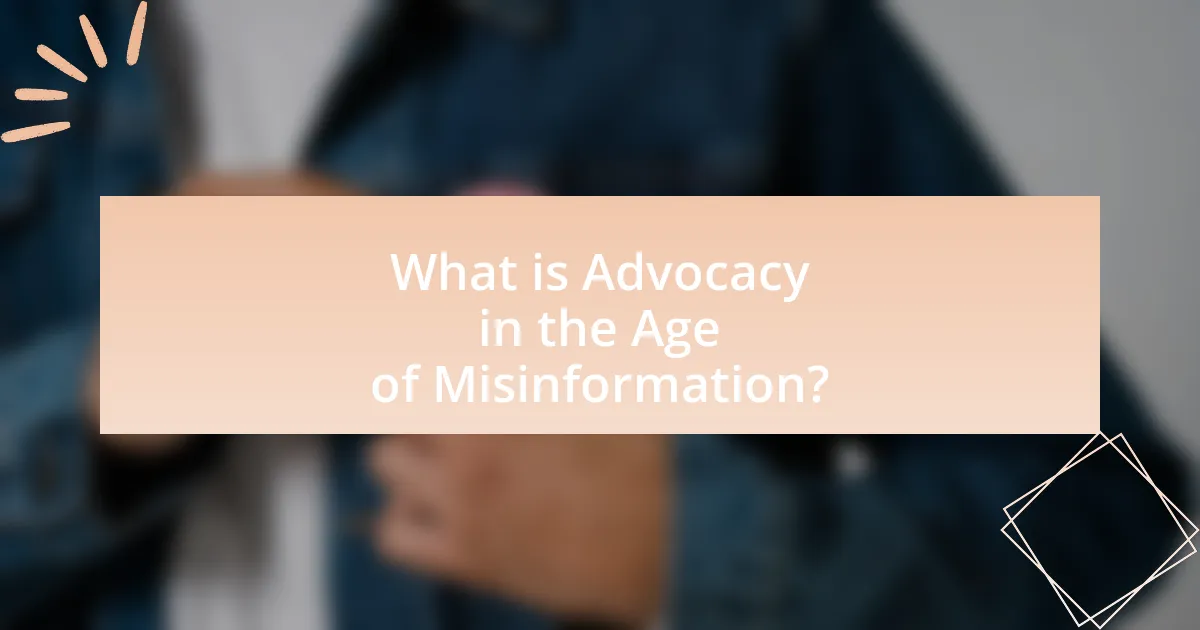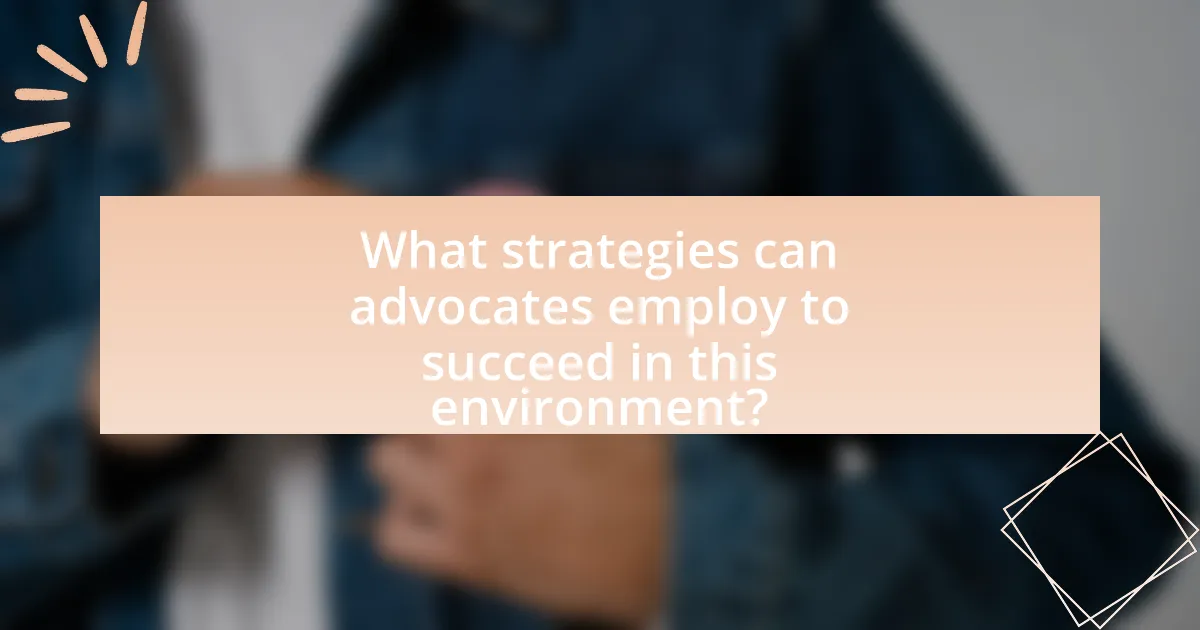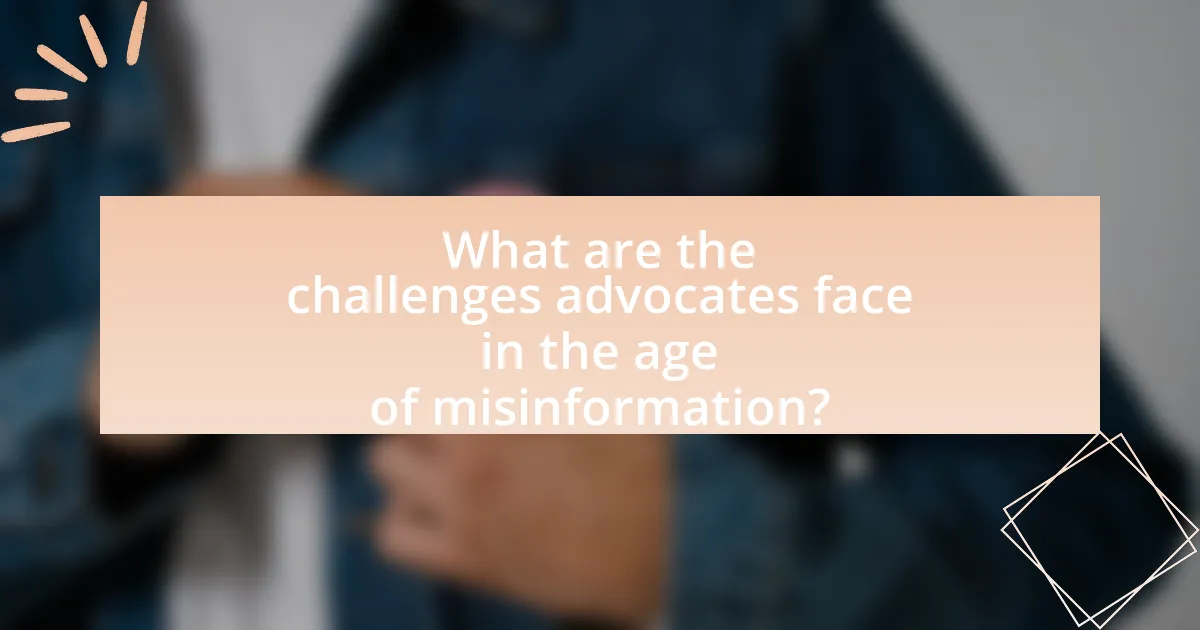Advocacy in the age of misinformation is a critical endeavor aimed at promoting accurate information and countering false narratives that can distort public perception and policy. This article explores the impact of misinformation on advocacy efforts, highlighting key types of misinformation, such as false claims and misleading statistics, and their effects on public trust. It discusses the importance of effective advocacy strategies, including fact-checking, media literacy education, and collaboration among diverse stakeholders, to combat misinformation and influence policy changes. Additionally, the article outlines best practices for advocates, emphasizing the need for clear communication, evidence-based messaging, and ongoing training to enhance their effectiveness in this challenging environment.

What is Advocacy in the Age of Misinformation?
Advocacy in the age of misinformation involves promoting accurate information and combating false narratives to influence public opinion and policy effectively. This form of advocacy is crucial as misinformation can distort facts, leading to misguided beliefs and actions. For instance, studies show that misinformation can significantly impact public health responses, as seen during the COVID-19 pandemic, where false information about the virus and vaccines led to vaccine hesitancy. Therefore, effective advocacy strategies must include fact-checking, media literacy education, and the use of credible sources to ensure that accurate information prevails in public discourse.
How has misinformation impacted advocacy efforts?
Misinformation has significantly undermined advocacy efforts by creating confusion and eroding public trust. Advocacy groups often struggle to convey accurate information when competing against false narratives, which can lead to misinformed public perceptions and hinder effective mobilization. For instance, a study by the Pew Research Center found that 64% of Americans believe misinformation has caused confusion about basic facts, impacting their ability to engage with advocacy campaigns. This confusion can dilute the effectiveness of messaging and reduce the overall impact of advocacy initiatives, as stakeholders may become skeptical or disengaged due to conflicting information.
What are the key types of misinformation affecting advocacy?
The key types of misinformation affecting advocacy include false information, misleading statistics, and fabricated narratives. False information refers to completely inaccurate claims that can undermine the credibility of advocacy efforts. Misleading statistics involve presenting data in a way that distorts the truth, often by omitting context or using selective data points, which can misguide public perception and policy decisions. Fabricated narratives are constructed stories that lack factual basis, designed to evoke emotional responses and sway opinions against or in favor of certain causes. These types of misinformation can significantly hinder effective advocacy by creating confusion, eroding trust, and polarizing public opinion.
How does misinformation alter public perception of advocacy issues?
Misinformation significantly alters public perception of advocacy issues by creating confusion and distrust among the audience. When false or misleading information spreads, it can distort the facts surrounding an issue, leading individuals to form opinions based on inaccuracies rather than evidence. For instance, a study published in the journal “Science” found that false information spreads faster and more widely than the truth on social media platforms, which can skew public understanding and support for advocacy efforts. This distortion can result in decreased engagement with legitimate advocacy campaigns, as individuals may become skeptical of the motives behind them or misinterpret the issues at stake.
Why is advocacy important in combating misinformation?
Advocacy is crucial in combating misinformation because it mobilizes individuals and organizations to promote accurate information and challenge false narratives. Effective advocacy raises awareness about the dangers of misinformation, educates the public on critical thinking and media literacy, and encourages accountability among information disseminators. For instance, studies show that advocacy campaigns can significantly reduce the spread of false information by fostering a culture of verification and responsible sharing, as evidenced by initiatives like the “Stop the Spread” campaign, which successfully countered COVID-19 misinformation through community engagement and education.
What role does advocacy play in promoting accurate information?
Advocacy plays a crucial role in promoting accurate information by actively challenging misinformation and supporting evidence-based narratives. Advocacy organizations, such as fact-checking groups and public health advocates, engage in campaigns that educate the public, provide reliable resources, and counter false claims. For instance, during the COVID-19 pandemic, organizations like the World Health Organization launched advocacy initiatives to disseminate accurate health information, which helped reduce the spread of misinformation and increased public trust in scientific data. This demonstrates that effective advocacy not only informs but also empowers individuals to discern credible information from falsehoods.
How can advocacy influence policy changes related to misinformation?
Advocacy can influence policy changes related to misinformation by mobilizing public opinion, engaging stakeholders, and providing evidence-based recommendations to policymakers. For instance, organizations like the Center for Democracy and Technology have successfully advocated for stronger regulations on social media platforms to combat misinformation, leading to legislative proposals that aim to enhance transparency and accountability. Additionally, advocacy efforts often include campaigns that raise awareness about the impacts of misinformation, which can shift public sentiment and pressure lawmakers to take action. This combination of public engagement and strategic recommendations creates a compelling case for policy reform in the realm of misinformation.

What strategies can advocates employ to succeed in this environment?
Advocates can succeed in the current environment by employing strategies such as leveraging data-driven messaging, building coalitions, and utilizing social media effectively. Data-driven messaging allows advocates to present factual evidence that counters misinformation, thereby enhancing credibility. Building coalitions with like-minded organizations amplifies their reach and influence, as seen in successful campaigns like the Climate Action Network, which unites various groups to advocate for climate policies. Additionally, effective use of social media enables advocates to engage directly with audiences, share accurate information rapidly, and counter false narratives in real-time, as demonstrated by various public health campaigns during the COVID-19 pandemic.
How can advocates effectively communicate their messages?
Advocates can effectively communicate their messages by utilizing clear, concise language and leveraging multiple platforms to reach diverse audiences. Research indicates that messages framed in simple, relatable terms are more likely to resonate with the public, as shown in a study by the Pew Research Center, which found that 70% of individuals prefer straightforward communication over complex jargon. Additionally, employing storytelling techniques can enhance emotional engagement, making the message more memorable. A report from the Stanford Social Innovation Review highlights that narratives can increase message retention by up to 65%. By combining clarity with emotional appeal and utilizing various communication channels, advocates can significantly improve the effectiveness of their messaging.
What techniques can be used to enhance message clarity?
To enhance message clarity, techniques such as using simple language, structuring information logically, and employing visual aids are effective. Simple language minimizes misunderstandings by avoiding jargon and complex terms, making the message accessible to a broader audience. Structuring information logically, such as using bullet points or numbered lists, helps the audience follow the argument or narrative easily. Visual aids, like charts or infographics, can reinforce key points and make complex data more digestible. Research indicates that clear communication significantly improves audience comprehension and retention, as demonstrated in studies on effective messaging strategies in public health campaigns.
How can storytelling be leveraged in advocacy communications?
Storytelling can be leveraged in advocacy communications by creating emotional connections that resonate with audiences, thereby enhancing engagement and understanding of complex issues. Effective narratives can simplify intricate topics, making them relatable and memorable, which is crucial in an era where misinformation is prevalent. For instance, research by the FrameWorks Institute highlights that stories can shift public perceptions and motivate action by illustrating the human impact of policies, thus fostering empathy and support for advocacy efforts.
What role does collaboration play in advocacy against misinformation?
Collaboration plays a crucial role in advocacy against misinformation by enabling diverse stakeholders to pool resources, expertise, and networks to effectively counter false narratives. When organizations, governments, and communities work together, they can amplify their reach and impact, creating a unified front that is more credible and persuasive. For instance, initiatives like the “Trust Project” bring together journalists, technologists, and academics to develop standards for transparency and trustworthiness in news, demonstrating how collaborative efforts can enhance the credibility of information sources. Additionally, research from the Pew Research Center indicates that collaborative fact-checking efforts significantly improve the accuracy of information shared online, showcasing the effectiveness of teamwork in combating misinformation.
How can partnerships enhance advocacy efforts?
Partnerships can enhance advocacy efforts by combining resources, expertise, and networks to amplify messages and reach broader audiences. Collaborative initiatives allow organizations to leverage each other’s strengths, such as shared funding, diverse skill sets, and established community connections. For instance, a study by the Stanford Social Innovation Review highlights that partnerships can increase the effectiveness of campaigns by up to 50% through coordinated outreach and unified messaging. This synergy not only improves visibility but also fosters trust and credibility among stakeholders, making advocacy efforts more impactful in combating misinformation.
What are the benefits of engaging with diverse stakeholders?
Engaging with diverse stakeholders enhances decision-making and fosters innovation. By incorporating varied perspectives, organizations can identify blind spots, leading to more comprehensive solutions. Research indicates that diverse teams are 35% more likely to outperform their less diverse counterparts, as highlighted in a McKinsey report. This diversity not only improves problem-solving but also strengthens community trust and collaboration, essential in advocacy efforts, especially in combating misinformation.

What are the challenges advocates face in the age of misinformation?
Advocates face significant challenges in the age of misinformation, primarily including the erosion of public trust and the difficulty in disseminating accurate information. Misinformation can lead to confusion among the public, making it harder for advocates to communicate their messages effectively. For instance, a study by the Pew Research Center found that 64% of Americans believe that misinformation has caused a great deal of confusion about the basic facts of important issues. This confusion complicates the ability of advocates to mobilize support and influence policy effectively. Additionally, advocates must contend with the rapid spread of false information on social media platforms, which can undermine their credibility and dilute their efforts.
How can advocates overcome skepticism from the public?
Advocates can overcome skepticism from the public by building trust through transparency and consistent communication. Establishing credibility involves sharing verifiable data and engaging with the community to address concerns directly. For instance, a study by the Pew Research Center found that 70% of people are more likely to trust information from organizations that provide clear sources and evidence. By actively listening to public feedback and adapting messages accordingly, advocates can foster a sense of collaboration and understanding, which further reduces skepticism.
What strategies can be used to build trust with audiences?
To build trust with audiences, organizations should prioritize transparency, consistency, and engagement. Transparency involves openly sharing information about processes, decisions, and potential conflicts of interest, which fosters credibility. Consistency in messaging and actions reinforces reliability, as audiences are more likely to trust entities that maintain a steady approach over time. Engagement through active listening and responding to audience feedback demonstrates that organizations value their stakeholders’ opinions, further solidifying trust. Research indicates that organizations perceived as transparent and consistent are more likely to gain audience trust, as highlighted in a study by the Edelman Trust Barometer, which found that 81% of consumers need to trust a brand before purchasing.
How can advocates address misinformation directly?
Advocates can address misinformation directly by employing fact-checking initiatives and promoting media literacy programs. Fact-checking initiatives involve verifying claims and disseminating accurate information to counter false narratives, as seen in organizations like Snopes and FactCheck.org, which have successfully debunked numerous viral myths. Additionally, promoting media literacy equips individuals with the skills to critically evaluate sources and discern credible information, thereby reducing the spread of misinformation. Research indicates that media literacy education can significantly improve critical thinking skills, leading to better information consumption habits.
What tools and resources are available for advocates?
Advocates have access to various tools and resources that enhance their effectiveness in combating misinformation. Key resources include digital platforms like social media for outreach, fact-checking websites such as Snopes and FactCheck.org for verifying information, and advocacy networks like the American Civil Liberties Union (ACLU) that provide support and training. Additionally, data visualization tools like Tableau can help advocates present information clearly, while online courses from organizations like Coursera offer training in communication strategies. These resources collectively empower advocates to engage effectively and promote accurate information.
What digital tools can assist in advocacy efforts?
Digital tools that can assist in advocacy efforts include social media platforms, email marketing software, and online petition services. Social media platforms like Twitter and Facebook enable advocates to reach a wide audience quickly, facilitating engagement and mobilization around issues. Email marketing software, such as Mailchimp, allows organizations to communicate directly with supporters, providing updates and calls to action. Online petition services like Change.org empower individuals to gather support for specific causes, making it easier to demonstrate public backing. These tools enhance the effectiveness of advocacy campaigns by increasing visibility, fostering community, and streamlining communication.
How can data and research support advocacy initiatives?
Data and research support advocacy initiatives by providing evidence-based insights that enhance credibility and inform decision-making. For instance, statistical data can highlight the prevalence of an issue, such as the 2020 report from the World Health Organization indicating that 1 in 5 people experience mental health issues, which can galvanize public support and policy changes. Additionally, research findings can identify effective strategies for outreach and engagement, as demonstrated by studies showing that targeted messaging increases community participation by up to 30%. By utilizing data and research, advocacy initiatives can craft compelling narratives that resonate with stakeholders and drive meaningful action.
What best practices should advocates follow for success?
Advocates should prioritize clear communication, evidence-based messaging, and building coalitions for success. Clear communication ensures that the message is easily understood and resonates with the target audience, which is crucial in an age where misinformation can easily spread. Evidence-based messaging, supported by credible data and research, enhances the legitimacy of the advocacy efforts and helps counteract false narratives. Building coalitions with like-minded organizations amplifies the reach and impact of advocacy initiatives, as collaboration can leverage diverse resources and expertise. These practices are essential for effectively navigating the complexities of advocacy in today’s information landscape.
How can advocates measure the effectiveness of their strategies?
Advocates can measure the effectiveness of their strategies by utilizing specific metrics such as engagement rates, policy changes, and public awareness levels. Engagement rates can be tracked through social media interactions, event attendance, and feedback surveys, providing quantitative data on how well the message resonates with the target audience. Policy changes serve as a direct indicator of advocacy success, as they reflect the tangible impact of efforts on legislation or community practices. Additionally, public awareness levels can be assessed through pre- and post-campaign surveys that gauge shifts in knowledge or attitudes regarding the issue at hand. These metrics collectively offer a comprehensive view of the effectiveness of advocacy strategies.
What ongoing training and education should advocates pursue?
Advocates should pursue ongoing training in digital literacy, critical thinking, and effective communication strategies. Digital literacy equips advocates to navigate and assess information sources, which is crucial in an era rife with misinformation. Critical thinking enhances their ability to analyze arguments and identify logical fallacies, enabling them to counter misleading narratives effectively. Effective communication training, including public speaking and social media engagement, ensures that advocates can convey their messages clearly and persuasively to diverse audiences. Research indicates that advocates who engage in continuous education in these areas are more successful in influencing public opinion and policy outcomes, as they are better prepared to address the complexities of misinformation.